Chicago-Style Italian Beef Sandwich
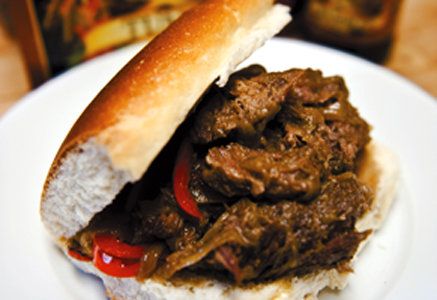 When I was in Chicago, working on the Brewers Association World Beer Cup Dinner, Randy Mosher introduced me to a sandwich that I had not had the pleasure of experiencing before — a Chicago-Style Italian Beef Sandwich, aka the Chicago Beef.
When I was in Chicago, working on the Brewers Association World Beer Cup Dinner, Randy Mosher introduced me to a sandwich that I had not had the pleasure of experiencing before — a Chicago-Style Italian Beef Sandwich, aka the Chicago Beef.
Since I don’t live in Chicago, Eater published a go-to list of places for the Italian Beef sandwich. I wanted to see what variations to the basic recipe, different sandwich shops around Chicago would take. Many of them use red wine as a braising medium, some water, other stock. As I love beer and wanted this classic sandwich to be cooked with beer | cooking in beer. I set out to better understand all the different ingredients, that make this regional sandwich stand apart from a standard roast beef sandwich or a French Dip. After many tries in the Home Brew Chef test kitchen, I came up with this Beer Cuisine version of the Chicago-Style Italian Beef Sandwich that I believe will rock your palate.
If you want to learn more about the history of this sandwich, check out Wikipedia.
How to Make a Chicago-Style Italian Beef Sandwich:
The beef!
Before we make the sandwich, it’s best to understand the ingredients before crafting the meat for the final sandwich. As the beef is what this sandwich is all about, getting into the food science, and understanding what to buy, how to best cook it, to get the best results is critical.
It is important to understand the differences between the muscle groups; how the muscle is used and what different fibers and tissues make up that muscle. A roast is defined as a cut, thicker or larger than 2 inches, making it larger than a steak (thinner than 2 inches). Depending on how much that muscle is used, the percentage of fat and other connective tissue (tendons, nerves, cartilaginous, fatty, and elastic tissues that create a supportive matrix) versus no connective tissue (being all muscle with some marbled fat) changes the cooking style | technique, to achieve the best results for that cut of meat. Most roasts are whole or divided into a part of a muscle. Roasts are more value cuts, getting more for less if you will. Less effort on the butcher side, keeping the meat as a whole roast instead of individual smaller steaks with more trim, creates cheaper prices.
When cooking meat, beef, pork, lamb, or any protein | vegetable, there are really two approaches, dry heat, and wet heat. Dry heat or roasting is using heat from a direct fire (hearth | grill | rotisserie | pizza oven | smoker), hot oven, stovetop (think cast iron pan for searing a steak), IE sauteing. It is interesting to note, that with the use of rendered fat or oil, for sauté, deep frying is also considered dry heat cooking (no moisture). This dry heat method is used for roasts that are more muscle, less connective tissue, think Tenderloin roast, Rib Eye Roast, or Prime Rib. In my Barleywine Marinated Prime Rib recipe, I cover the rib roast with salt, to defuse the dry heat of the oven, slowly cooking the meat, to the perfect temperature of doneness (raw | rare | medium-rare | medium | medium-well | well | burnt). This cooking method can be broken down even further, with hot and quick versus low and slow cooking with the same dry heat cooking technique. As a roast is thicker and has more mass, it takes longer to get the center of the roast to the perfect doneness. This is why low and slow is usually the preferred method for cooking a roast. Think about a brisket (Texas Style Smoked Beef Brisket) being cooked by smoke, with radiant heat. This long (sometimes up to 14 -18 hours) cook time, slowly breaks down the connective tissue, melting the collagen when the brisket reaches that perfect 205°F | 96°C internal temperature.
Wet heat is defined by using moisture with heat. This cooking method includes steaming, poaching, simmering, braising, sous vide and stewing. This can be achieved with water, stock, beer, wine, spirits, and | or the meat’s own juices. In a pot roast recipe, which usually is a tougher cut of meat, with more connective tissue, wet heat is preferred, braising the roast. The pot roast is usually in a Dutch-oven, sealed, creating steam to melt the collagen (a main ingredient in the connective tissues) that creates that stick to the top of your mouth succulents… My Irish-Style Pot Roast recipe uses a chuck roast that is beer-braised in Irish stout, along with vegetables. The long, slow cooking of a pot roast transforms an inexpensive cut of beef into an exquisite feast. Chuck roast needs to be cooked longer. In this wet heat culinary technique, steam is created from 140°F | 60°C to a maximum of 212°F | 100°C or when liquid is boiling. This gentle heat is also very humid. That humidity has more thermal mass than the heat coming off a fire. This is one of the reasons why sous vide cooking technique is so incredible. Water is 26 times denser than air, cooking at a consistent temperature on all sides, making even cooking with no flipping and repeatable execution. This is were the same cut, in this example a brisket can be also cooked by wet heat, like my Stout Cured Corned Beef and Cabbage recipe, simmering in stout, low and slow, while only needed 2 1/2 – 3 hours of cooking on a burner at 212°F | 100°C instead of a water bath or sous-vide set to 180°F | 82.2°C for 8 hours.
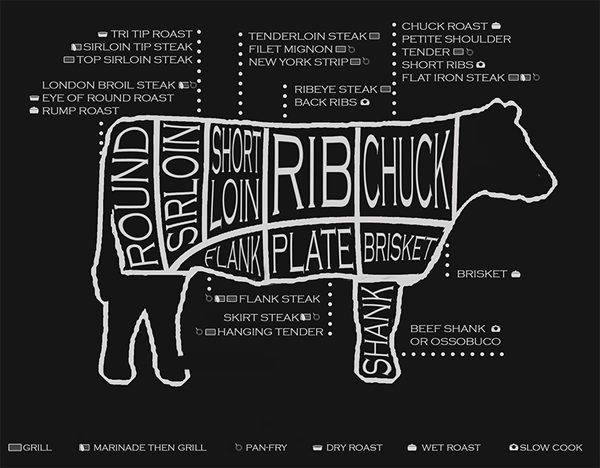
With this culinary food science, let us refocus on the prize: Chicago-Style Italian Beef Sandwich. What is the best cut of beef to use? In my research, I noticed other chefs and recipes using a Sirloin roast, Chuck roast, and a Rump roast. All these roasts share the same seam, just different sides of the track, so to speak. Let’s breakdown the different roasts into the meat fibers, marbling or fat dispersed through the muscle, connective tissue, and where the roast is located, indicating how much the muscle was used and the resulting flavor.
Chuck Roast is located in the forequarters, in the front of the cow. This roast has chunky marbling, larger pockets of fat, which some renders out, but stays in the meat. It has a lot of flavor because of this fat. This roast benefits from a long, wet heat cooking and a preferred roast for pot roast. When cooked, the meat melts on the palate, usually very moist and luscious.
Sirloin Roast muscle is more firm and solid. Located on the hindquarter, the muscle won’t shred or pull apart, as there isn’t the extra fat marbled through the whole muscle, more of a fine marbling. This roast is leaner, as this muscle is used more and will hold together more when sliced. The flavor is good, not as moist, and can dry out if overcooked.
Rump Roast meat fiber or grain is wider, having streaks of fat, a more weeping, or soft fat. Also located at the rear of the cow, this muscle doesn’t have as much connective tissue, resulting in less collagen. This cut is best cooked with wet heat, resulting in a good flavor. Yet without the extra collagen, a Rump Roast doesn’t have the same succulence as a Chuck Roast, and cooking over medium-rare my dry out and be tougher on the chew factor. Sometimes this roast is used for roast beef, as it does slice well.
To compare, Inside Round | Bottom Round roasts are traditionally used for roast beef, found in deli counters everywhere. This roast is large in size, some marbled fat, but mostly muscle, ultimately holding together better, when cooked with dry heat and sliced to make a sandwich.
Beer au Jus
To build flavor, especially with a protein like beef, the Maillard reaction is an important culinary term I mention a lot. It is defined as “a chemical reaction between amino acids and reducing sugars that gives browned food its distinctive flavor.” This chemical reaction occurs when meat | protein is seared and forms a crust on the outside, helping seal in the juices into the meat. The Maillard reaction also happens with malted barley as it is kilned, making a caramelized malt, that is used to make Brown Ales (both English Brown Ales and American Brown Ales, the hopper of the two) This same Maillard reaction is why caramelized onions are so delicious and roasted garlic has the flavor it does. The chef and the brewer combine cooking knowledge in this cooking with beer recipe. This leads me to adapt the recipe to highlight these flavor similarities and coax these flavors into the beef and the resulting beer braising liquid. I describe below how to caramelize the onions, to further the depth of flavor out of this allium family member, that braises with the beef and a Brown Ale. Italian culinary herbs are used to add the regional flavor profile. This all combines to craft a Beer au Jus that can be later used to rewarm the cooled and sliced meat, becoming the condiment, in the sandwich. Peppers are also sautéed and add a pop of flavor and texture. Plus, as Chicago is such a Beer Town, with so many amazing breweries, using beer seems more appropriate than other liquids.
One of the other benefits of making this recipe at home is, as the roast is cooking, the added benefit of the fragrance that escapes the oven, fills the house with a wonderful aroma of comfort, layers of salivating scenes, arching back to our ancestors, cooking on the hearth.
To finish the Chicago-Style Italian Beef Sandwich:
As the beef is beer-braised, creating rich and delicious meat, there needs to be a counterpoint to it. Instead of adding pickles or a type of pickled vegetable, as used in many different sandwiches, the Chicago-Style Italian Beef Sandwich is finished with giardiniera. This Italian condiment comes in mild or Chicago Style Hot contains assorted vegetables, including bell peppers, carrots, celery, cauliflower, sometimes serrano peppers, or other spicier chili pepper or crushed red pepper flakes gherkins, that are pickled in red wine vinegar, herbs, spices, and olive oil. It makes this sandwich as authentic as possible, bringing a much-needed acid to cut that richness.
The roll is also special. Plain, this roll is nondescript, more of a vehicle to hold the meat and toppings to get to your mouth. The roll also acts like a sponge. This style sandwich is like a French Dip and when ordering, it should be ‘Dipped’ in the Beer au Jus. Some will even go another dip or the “double-dip”!!! This French-style bread can be found at Gonnella Bakery Some sandwich shops offer cheese, provolone being the Italian choice, with a slight tang, melting evenly, and adding to the textural elements of the final sandwich.
Hungry yet?!?! May 27th is also National Italian Beef Day!
I hope you enjoy this culinary vacation to Chicago and remember, Eat Beer!
Makes: 6 sandwiches
Adapted from BeerAdvocate Magazine: Cuisine à la Bière | Oct 2010 | Issue #45
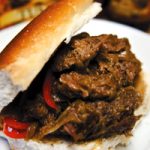
| Servings | Prep Time |
| 6 guests | 15 minute |
| Cook Time | Passive Time |
| 3 hour | 24 hour |
|
|

|
Learn the food science behind the iconic Chicago-Style Italian Beef Sandwich with an amazing Brown Ale Beer au Jus to dip it in!
|
- 4 - 5 pound beef, either a sirloin, chuck or rump roast
- 2 tablespoon salt, kosher
- 1 cup garlic, cloves peeled
- 3 tablespoon oregano or marjoram, fresh, leaves only
- 3 tablespoon thyme fresh, leaves only
- 2 tablespoon rosemary fresh, leaves only
- 36 ounce beer, such as English Brown Ale or American Brown Ale
- 3 each bay leaves preferably fresh
- 1 - 4 pinch Red Pepper Flakes or dried chili (optional)
- 2 tablespoon oil, olive
- 3 each onion, yellow, peeled and sliced
- 1 tablespoon oil, olive
- 1 each pepper, red bell, seeded and sliced
- 1 each pepper, yellow bell, seeded and sliced
- 6 each rolls, Italian style
- cheese, provolone, (optional)
-
giardiniera, pickled Italian style vegetables, available here: Chicago Style Hot
- Take the roast beef and rub the salt on all sides, massaging it into the nooks and crannies of the roast. In the pitcher of a blender, add the garlic, oregano, thyme, rosemary, half of the Brown Ale, and the red pepper flakes (if using) and purée into a sauce, not completely smooth, but with a little chunk. Place the roast into a seal-able container or bag and add the marinade, making sure the meat is covered, covering with additional beer if needed. Place into the refrigerator and let the beef roast marinate for at least 4 hours, preferably 24 – 48 hours.
- Preheat the oven to 300°F | 149°C.
- In a Dutch oven, over medium heat, add the oil and the onions, sautéing until transparent, about 12 minutes. Add the roast and marinade to the onions and any remaining beer not used in the marinade. The roast should be completely submerged. Season with black pepper and, using tongs, nestle the roast into the onions. Place uncovered into the oven and bake for 2 – 3 hours, depending on the cut and size. The meat should be tender and slightly pink on the inside. The ideal internal temperature should be 140°F | 60°C for Medium Rare, 145°F | 63°C for Medium and 150°F | 66°C for Medium Well.
- Remove the roast from the braising liquid and let rest to room temperature. Save the contents of the pot, as they will be used to finish the sandwich, creating a Beer au Jus.
- In a sauté pan, over medium heat, add the oil and wait until ripples form in the pan. Add the prepared peppers and sauté until they wilt, but still hold their shape. Season lightly with salt and pepper, and add to the onion beer mixture in the Dutch oven. Bring this mixture to a low simmer.
- Meanwhile, slice the cooled and preferably chilled roast as thin as possible, cutting against the grain (cutting with the grain can cause a tough, ropey texture).
- To serve this sandwich, cut the Italian-style rolls in half. Using tongs, grab a healthy portion of meat, add the meat back into the hot onion pepper Beer au Jus and toss to coat, quickly reheating the meat. Make sure you take some onions & peppers, placing them into the roll (making sure that the bay leaves don’t end up in the sandwich).
- The roll will soak up the remaining juices off the beef. But, like a French Dip, I recommend dipping the whole sandwich in the Beer au Jus, for the authentic 'Dip'.
- The sandwich can be topped with provolone cheese, or you can go traditional and serve without cheese and | or add some lightly pickled Italian-style vegetables (called “Chicago Style Hot Giardiniera'
”) such as cauliflower, onions, peppers, and carrots. Traditionally, french fries are served alongside this beast of a sandwich.
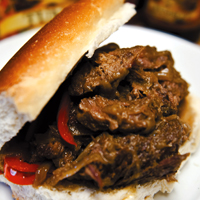
More Beer Sandwich Recipes:


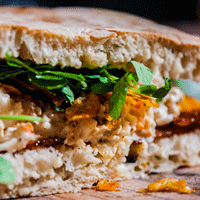

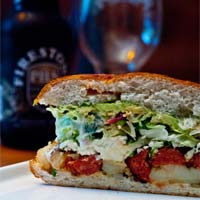
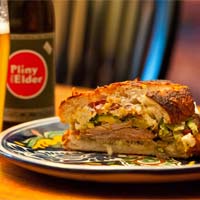





Italian beef from Chicago 99% of the time uses top round or bottom round. All these other cuts are typically not suitable either too fatty or too tough.
Thanks for the comment, Scott. I do suggest the Sirloin Roast, which can be broken down into a top or bottom roast. A true Top or Bottom Roast is cheaper and has the least amount of fat.